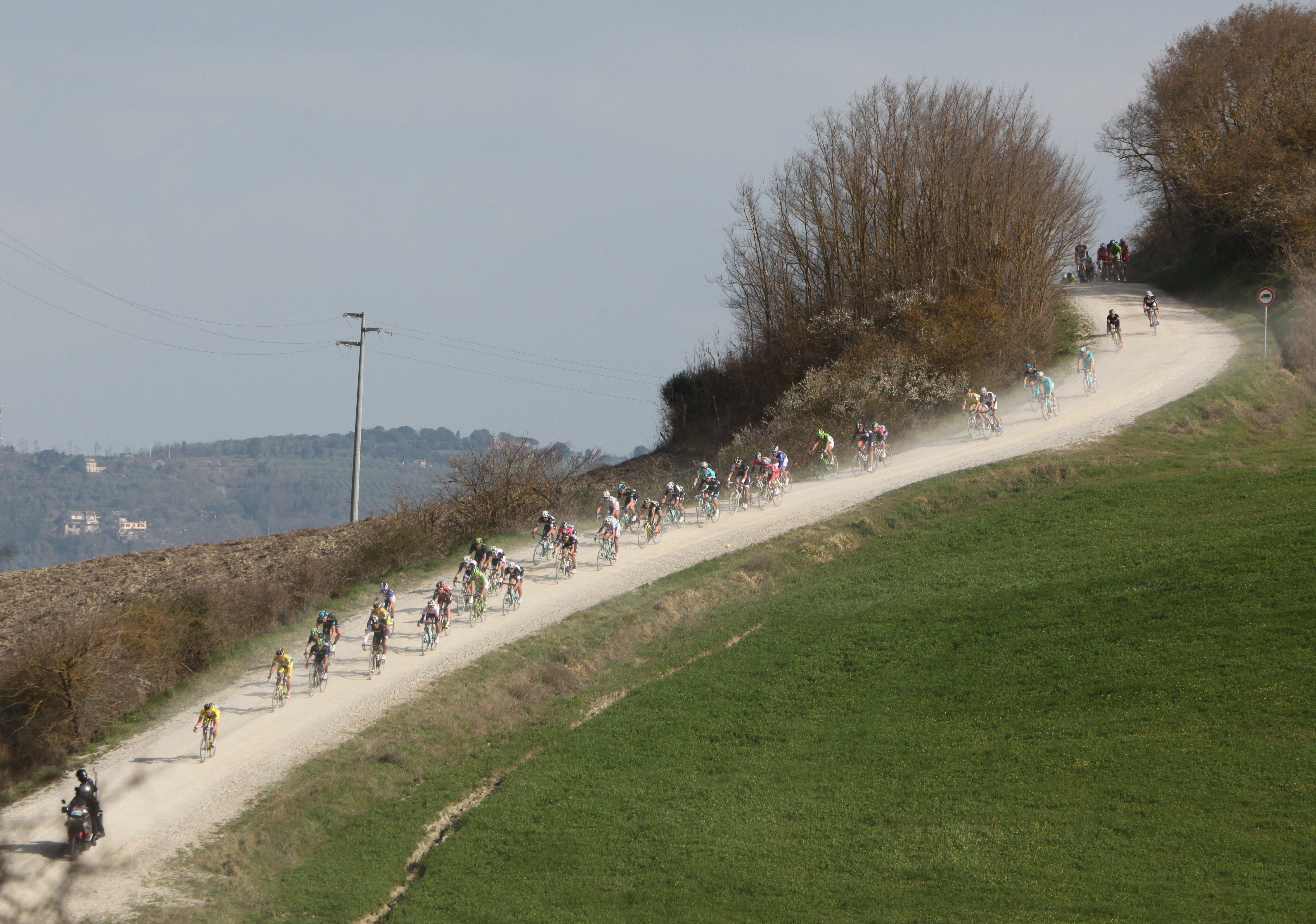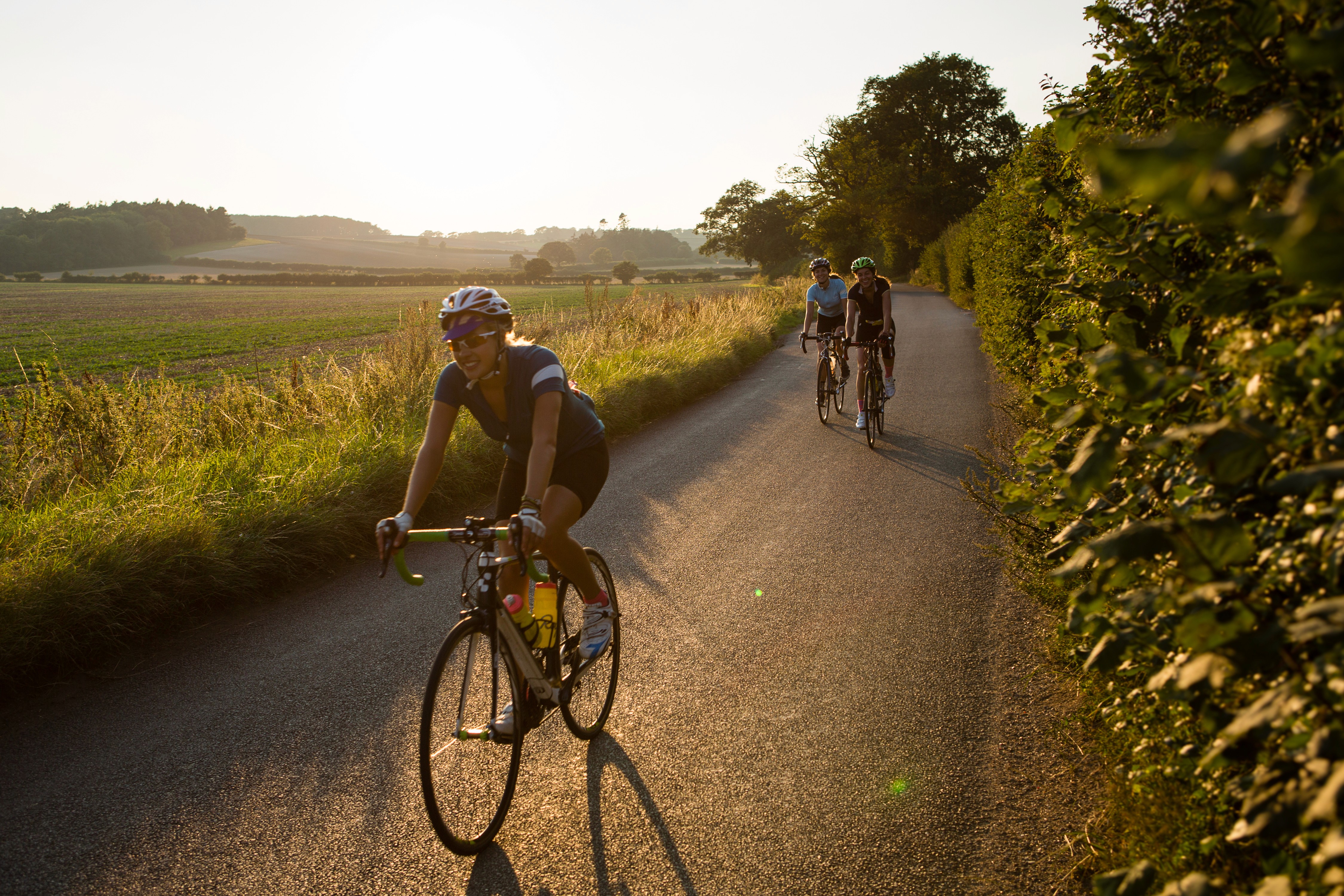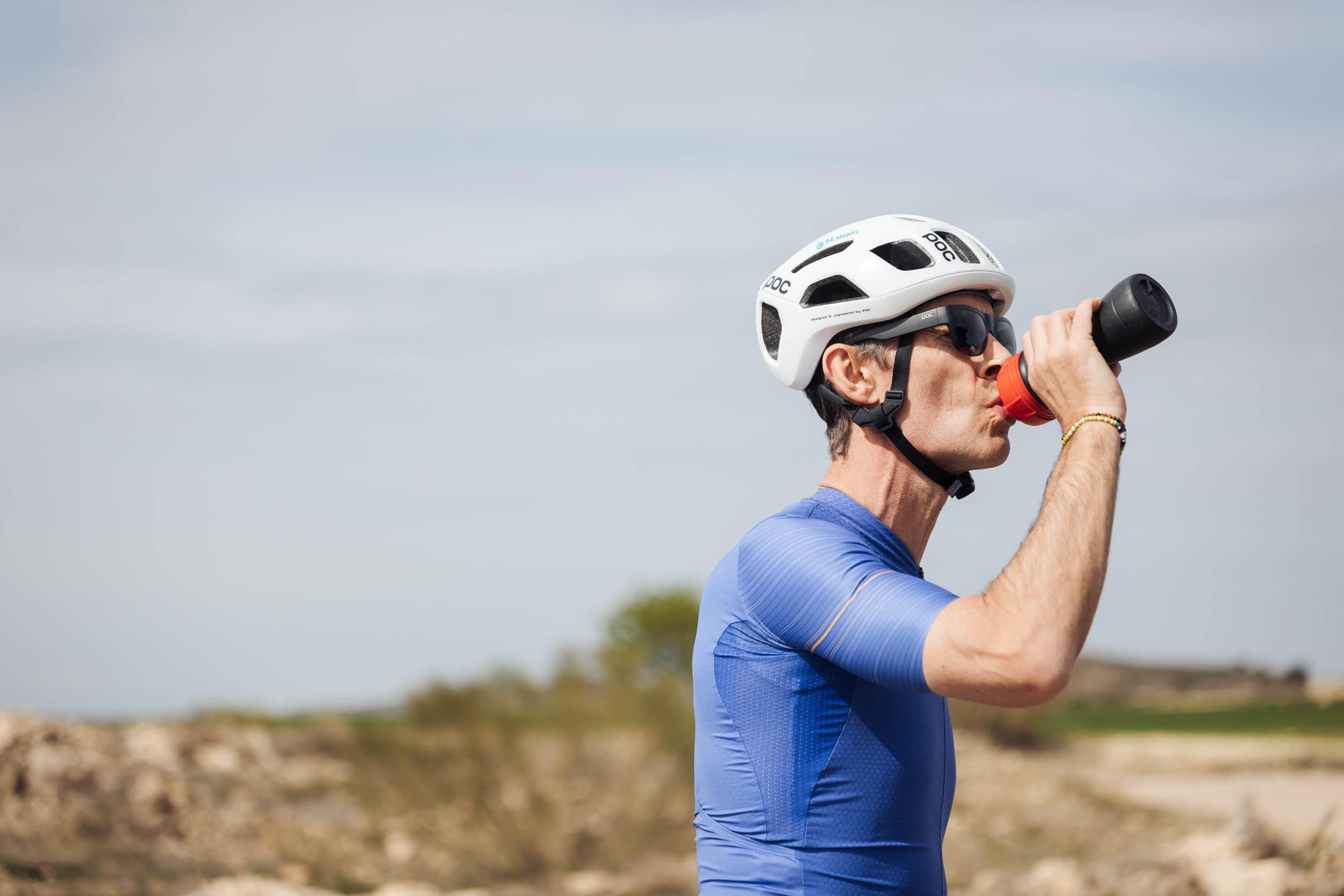The Art of Gravel Riding

Aug 10, 2020

The Art of Gravel Riding
Aug 10, 2020

The Art of Gravel Riding

Aug 10, 2020

Not that long ago most cyclists would make a U-turn when they suddenly hit upon a gravel road. Nowadays, the internet is searched for 'undiscovered' gravel paths and a gravel bike is part of the standard equipment of many cyclists. With the ultimate gravel race, the Strade Bianche in Tuscany, Italy, just around the corner, we zoom in on the 'key elements' of riding on gravel.
Gravel Race
Strade Bianche, which literally translates as 'white roads', is a very young classic race with 13 editions to its name in 2019, and the 2020 edition will be number 14. Yet on its short list of winners you'll see some very well-known names. Swiss hard man Fabian Cancellara won it three times and Poland's Michal Kwiatkowski finished first twice. It's also noticeable that many cyclo-cross riders have made it to the podium, like Wout van Aert. That a cyclo-cross rider like Van Aert or a cobbles specialist like Cancellara excel on the gravel paths around Siena is not surprising. Because riding cobblestones, cyclo-cross or gravel is different from racing on tarmac in a number of ways.
Rolling resistance on gravel
First of all, the gravel surface provides greater rolling resistance. This means that at a constant power output, the amount of rolling resistance as part of the total resistance is higher on gravel than on asphalt. Assuming that the slope remains the same, this means that another resistance component, the aerodynamic one, plays a less important role. This means that the so-called 'draft effect' (the effect of reduced air resistance when you ride behind the rider in front of you) is also lower. In other words, a cyclist cannot "hide" and save energy as much as you can in a large peloton on tarmac, but has to rely on his own abilities more. Additionally, because of the increased rolling resistance, the speeds tend to be lower as well, which makes the air resistance even less of a factor and thereby the 'draft effect' even smaller still.
In addition on a gravel road there are often only one or two lines on the track that are good to ride on. That's why a peloton on a gravel road often stretches out in a long ribbon. When you are too far at the back of the peloton, it is quite difficult to get back in the race (a long line of riders to overtake while the good lines on the gravel road are basically taken up by all those riders ahead). Good classic riders therefore understand that it is vital to stay near the front of the peloton on an important section, with or without help from teammates. This strategy only makes the gravel race harder, as the urge to be near the front will only further increase the pace of the peloton.
How to avoid snakebite flats
Once you've started the gravel section from somewhere near the front, you can't sit too close on the wheel of the rider in front of you. If he makes a mistake, then you have a problem as well. Keeping better sight of the upcoming stretches of road is another good reason to stay near the front of the peloton. Also, a gravel section is usually not very smooth and you want to avoid hitting the holes in the road. Because if you ride flat out through these holes, you run the risk of snakebite flats in both tires.
A completely different remedy to avoid snakebite flats is of course to fit tubeless tires. If you cannot avoid a hole, it is important to lift your butt and distribute your weight, so that your body absorbs the shock instead of the rim and tires on your bicycle's wheels. It is also important to hit hard segments of gravel road at high speed and keep the momentum for as long as possible. The handling of the handlebar is something of an art as well. You cannot hold it too tightly or your hands will become all blistered really quickly, but because of the bad roads you still need to grip the bars with some conviction. Your weight should not be too much on the front wheel, so that you can let the front wheel find its way. And absorb potholes hits with your arms.
So on gravel a cyclist is more dependent on himself and can benefit less from teammates or the rider in front. Therefore everyone wants to start from the front to choose their own track and keep the speed as high as possible to take that kinetic energy with them. This is an ideal cocktail for a cycling war on every gravel section and that's exactly what makes Strade Bianche so exciting and an instant classic from the first edition. To the average Joe, riding gravel is mainly about the great outdoor experience in beautiful surroundings, often without cars and other traffic to spoil the fun.
The specifics of a gravel bikeFinally, a word about the gravel bike. Bicycle companies will tell you that everyone needs a gravel bike, of course! But most of the pro's don't ride on gravel bikes that often. And if they do, it's likely more a publicity blitz for their bicycle brand sponsor rather than their own choice. Compared to a normal road bike, a gravel bike has a somewhat lazier geometry. This means that the head tube is less steep and therefore the bike handles a little less aggressively. Also the rear fork is often a bit longer for the same effect and more comfort. The gravel bike is usually also designed to provide a little more comfort on rougher surfaces. That often makes them too heavy and not stiff enough to serve as a weapon of choice for the pro's.
Tires on a Gravel Bike
A gravel bike obviously has a lot more tire clearance, to allow for the use of much wider tires than on a road bike. The wider the tire, the lower the pressure can be, which improves comfort a lot. Tubeless tires are also a very good idea here, as the absence of an inner tube eliminates the risk of snakebite flats. Broader tires are also heavier and with that gravel thread pattern, their rolling resistance when used on tarmac is a lot higher. Broader tires also make disc brakes a must. So pro's usually ride with tires that are not wider than 26 mm-28 mm to be able to still go fast on the tarmac stretches that most races still have.If you don't ride the most extreme gravel roads, you can use your regular road bike fitted with 28 mm or 30 mm tubeless tires (if they fit in that road bike's frame), with slightly lower tire pressure than you would apply on the road. Maybe don't use your Zipp 808 rims, but opt for a lower and less stiff rim with a few spokes more than in weight weenie road rims. Don't start sprinting at the first gravel section either, but ease into it.
Not that long ago most cyclists would make a U-turn when they suddenly hit upon a gravel road. Nowadays, the internet is searched for 'undiscovered' gravel paths and a gravel bike is part of the standard equipment of many cyclists. With the ultimate gravel race, the Strade Bianche in Tuscany, Italy, just around the corner, we zoom in on the 'key elements' of riding on gravel.
Gravel Race
Strade Bianche, which literally translates as 'white roads', is a very young classic race with 13 editions to its name in 2019, and the 2020 edition will be number 14. Yet on its short list of winners you'll see some very well-known names. Swiss hard man Fabian Cancellara won it three times and Poland's Michal Kwiatkowski finished first twice. It's also noticeable that many cyclo-cross riders have made it to the podium, like Wout van Aert. That a cyclo-cross rider like Van Aert or a cobbles specialist like Cancellara excel on the gravel paths around Siena is not surprising. Because riding cobblestones, cyclo-cross or gravel is different from racing on tarmac in a number of ways.
Rolling resistance on gravel
First of all, the gravel surface provides greater rolling resistance. This means that at a constant power output, the amount of rolling resistance as part of the total resistance is higher on gravel than on asphalt. Assuming that the slope remains the same, this means that another resistance component, the aerodynamic one, plays a less important role. This means that the so-called 'draft effect' (the effect of reduced air resistance when you ride behind the rider in front of you) is also lower. In other words, a cyclist cannot "hide" and save energy as much as you can in a large peloton on tarmac, but has to rely on his own abilities more. Additionally, because of the increased rolling resistance, the speeds tend to be lower as well, which makes the air resistance even less of a factor and thereby the 'draft effect' even smaller still.
In addition on a gravel road there are often only one or two lines on the track that are good to ride on. That's why a peloton on a gravel road often stretches out in a long ribbon. When you are too far at the back of the peloton, it is quite difficult to get back in the race (a long line of riders to overtake while the good lines on the gravel road are basically taken up by all those riders ahead). Good classic riders therefore understand that it is vital to stay near the front of the peloton on an important section, with or without help from teammates. This strategy only makes the gravel race harder, as the urge to be near the front will only further increase the pace of the peloton.
How to avoid snakebite flats
Once you've started the gravel section from somewhere near the front, you can't sit too close on the wheel of the rider in front of you. If he makes a mistake, then you have a problem as well. Keeping better sight of the upcoming stretches of road is another good reason to stay near the front of the peloton. Also, a gravel section is usually not very smooth and you want to avoid hitting the holes in the road. Because if you ride flat out through these holes, you run the risk of snakebite flats in both tires.
A completely different remedy to avoid snakebite flats is of course to fit tubeless tires. If you cannot avoid a hole, it is important to lift your butt and distribute your weight, so that your body absorbs the shock instead of the rim and tires on your bicycle's wheels. It is also important to hit hard segments of gravel road at high speed and keep the momentum for as long as possible. The handling of the handlebar is something of an art as well. You cannot hold it too tightly or your hands will become all blistered really quickly, but because of the bad roads you still need to grip the bars with some conviction. Your weight should not be too much on the front wheel, so that you can let the front wheel find its way. And absorb potholes hits with your arms.
So on gravel a cyclist is more dependent on himself and can benefit less from teammates or the rider in front. Therefore everyone wants to start from the front to choose their own track and keep the speed as high as possible to take that kinetic energy with them. This is an ideal cocktail for a cycling war on every gravel section and that's exactly what makes Strade Bianche so exciting and an instant classic from the first edition. To the average Joe, riding gravel is mainly about the great outdoor experience in beautiful surroundings, often without cars and other traffic to spoil the fun.
The specifics of a gravel bikeFinally, a word about the gravel bike. Bicycle companies will tell you that everyone needs a gravel bike, of course! But most of the pro's don't ride on gravel bikes that often. And if they do, it's likely more a publicity blitz for their bicycle brand sponsor rather than their own choice. Compared to a normal road bike, a gravel bike has a somewhat lazier geometry. This means that the head tube is less steep and therefore the bike handles a little less aggressively. Also the rear fork is often a bit longer for the same effect and more comfort. The gravel bike is usually also designed to provide a little more comfort on rougher surfaces. That often makes them too heavy and not stiff enough to serve as a weapon of choice for the pro's.
Tires on a Gravel Bike
A gravel bike obviously has a lot more tire clearance, to allow for the use of much wider tires than on a road bike. The wider the tire, the lower the pressure can be, which improves comfort a lot. Tubeless tires are also a very good idea here, as the absence of an inner tube eliminates the risk of snakebite flats. Broader tires are also heavier and with that gravel thread pattern, their rolling resistance when used on tarmac is a lot higher. Broader tires also make disc brakes a must. So pro's usually ride with tires that are not wider than 26 mm-28 mm to be able to still go fast on the tarmac stretches that most races still have.If you don't ride the most extreme gravel roads, you can use your regular road bike fitted with 28 mm or 30 mm tubeless tires (if they fit in that road bike's frame), with slightly lower tire pressure than you would apply on the road. Maybe don't use your Zipp 808 rims, but opt for a lower and less stiff rim with a few spokes more than in weight weenie road rims. Don't start sprinting at the first gravel section either, but ease into it.
Not that long ago most cyclists would make a U-turn when they suddenly hit upon a gravel road. Nowadays, the internet is searched for 'undiscovered' gravel paths and a gravel bike is part of the standard equipment of many cyclists. With the ultimate gravel race, the Strade Bianche in Tuscany, Italy, just around the corner, we zoom in on the 'key elements' of riding on gravel.
Gravel Race
Strade Bianche, which literally translates as 'white roads', is a very young classic race with 13 editions to its name in 2019, and the 2020 edition will be number 14. Yet on its short list of winners you'll see some very well-known names. Swiss hard man Fabian Cancellara won it three times and Poland's Michal Kwiatkowski finished first twice. It's also noticeable that many cyclo-cross riders have made it to the podium, like Wout van Aert. That a cyclo-cross rider like Van Aert or a cobbles specialist like Cancellara excel on the gravel paths around Siena is not surprising. Because riding cobblestones, cyclo-cross or gravel is different from racing on tarmac in a number of ways.
Rolling resistance on gravel
First of all, the gravel surface provides greater rolling resistance. This means that at a constant power output, the amount of rolling resistance as part of the total resistance is higher on gravel than on asphalt. Assuming that the slope remains the same, this means that another resistance component, the aerodynamic one, plays a less important role. This means that the so-called 'draft effect' (the effect of reduced air resistance when you ride behind the rider in front of you) is also lower. In other words, a cyclist cannot "hide" and save energy as much as you can in a large peloton on tarmac, but has to rely on his own abilities more. Additionally, because of the increased rolling resistance, the speeds tend to be lower as well, which makes the air resistance even less of a factor and thereby the 'draft effect' even smaller still.
In addition on a gravel road there are often only one or two lines on the track that are good to ride on. That's why a peloton on a gravel road often stretches out in a long ribbon. When you are too far at the back of the peloton, it is quite difficult to get back in the race (a long line of riders to overtake while the good lines on the gravel road are basically taken up by all those riders ahead). Good classic riders therefore understand that it is vital to stay near the front of the peloton on an important section, with or without help from teammates. This strategy only makes the gravel race harder, as the urge to be near the front will only further increase the pace of the peloton.
How to avoid snakebite flats
Once you've started the gravel section from somewhere near the front, you can't sit too close on the wheel of the rider in front of you. If he makes a mistake, then you have a problem as well. Keeping better sight of the upcoming stretches of road is another good reason to stay near the front of the peloton. Also, a gravel section is usually not very smooth and you want to avoid hitting the holes in the road. Because if you ride flat out through these holes, you run the risk of snakebite flats in both tires.
A completely different remedy to avoid snakebite flats is of course to fit tubeless tires. If you cannot avoid a hole, it is important to lift your butt and distribute your weight, so that your body absorbs the shock instead of the rim and tires on your bicycle's wheels. It is also important to hit hard segments of gravel road at high speed and keep the momentum for as long as possible. The handling of the handlebar is something of an art as well. You cannot hold it too tightly or your hands will become all blistered really quickly, but because of the bad roads you still need to grip the bars with some conviction. Your weight should not be too much on the front wheel, so that you can let the front wheel find its way. And absorb potholes hits with your arms.
So on gravel a cyclist is more dependent on himself and can benefit less from teammates or the rider in front. Therefore everyone wants to start from the front to choose their own track and keep the speed as high as possible to take that kinetic energy with them. This is an ideal cocktail for a cycling war on every gravel section and that's exactly what makes Strade Bianche so exciting and an instant classic from the first edition. To the average Joe, riding gravel is mainly about the great outdoor experience in beautiful surroundings, often without cars and other traffic to spoil the fun.
The specifics of a gravel bikeFinally, a word about the gravel bike. Bicycle companies will tell you that everyone needs a gravel bike, of course! But most of the pro's don't ride on gravel bikes that often. And if they do, it's likely more a publicity blitz for their bicycle brand sponsor rather than their own choice. Compared to a normal road bike, a gravel bike has a somewhat lazier geometry. This means that the head tube is less steep and therefore the bike handles a little less aggressively. Also the rear fork is often a bit longer for the same effect and more comfort. The gravel bike is usually also designed to provide a little more comfort on rougher surfaces. That often makes them too heavy and not stiff enough to serve as a weapon of choice for the pro's.
Tires on a Gravel Bike
A gravel bike obviously has a lot more tire clearance, to allow for the use of much wider tires than on a road bike. The wider the tire, the lower the pressure can be, which improves comfort a lot. Tubeless tires are also a very good idea here, as the absence of an inner tube eliminates the risk of snakebite flats. Broader tires are also heavier and with that gravel thread pattern, their rolling resistance when used on tarmac is a lot higher. Broader tires also make disc brakes a must. So pro's usually ride with tires that are not wider than 26 mm-28 mm to be able to still go fast on the tarmac stretches that most races still have.If you don't ride the most extreme gravel roads, you can use your regular road bike fitted with 28 mm or 30 mm tubeless tires (if they fit in that road bike's frame), with slightly lower tire pressure than you would apply on the road. Maybe don't use your Zipp 808 rims, but opt for a lower and less stiff rim with a few spokes more than in weight weenie road rims. Don't start sprinting at the first gravel section either, but ease into it.
More Relevant Articles
Discover valuable training tips to enhance your cycling performance.
More Relevant Articles
Discover valuable training tips to enhance your cycling performance.
More Relevant Articles
Discover valuable training tips to enhance your cycling performance.

Unlock Your Cycling Potential Today
Join thousands of cyclists who have improved their performance with JOIN's training plans.
Probeer het nu
Meer Informatie

Unlock Your Cycling Potential Today
Join thousands of cyclists who have improved their performance with JOIN's training plans.
By joining, you agree to our Terms and Conditions and our Privacy Policy.

Unlock Your Cycling Potential Today
Join thousands of cyclists who have improved their performance with JOIN's training plans.
By joining, you agree to our Terms and Conditions and our Privacy Policy.
Join Now
Join Now



